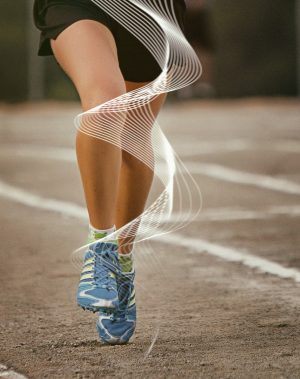
December 7, 2017
Salk researchers discover spinal cord neurons that inhibit distracting input to focus on task at hand
Salk researchers discover spinal cord neurons that inhibit distracting input to focus on task at hand
LA JOLLA—We think of our brain as masterminding all of our actions, but a surprising amount of information related to movement gets processed by our spinal cord.
Now, Salk Institute scientists have solved a longstanding mystery about how our spinal cord knows when to pay attention to certain pieces of information, and when to ignore it as distracting from the task at hand.

Credit: Salk Institute/Yolanda Leenders-Goulding
The work, appearing in the journal Neuron on December 7, 2017, reveals that specific neurons called RORbeta (RORβ) interneurons inhibit transmission of potentially disruptive sensory information during walking in order to promote a fluid gait. The research illustrates a high level of sophistication in spinal cord information processing.
"This research provides a sense of how the nervous system deals with the different types of information that's coming in to it, and how it uses that information in a way that's relevant to what it's actually doing at the time," says Martyn Goulding, a professor in Salk's Molecular Neurobiology Laboratory. "Your spinal cord is incredibly smart."
When we are moving, motor circuits in the spinal cord are constantly being barraged by information from sensory receptors in the skin and muscles, telling these circuits what our limbs are doing or what the ground underfoot feels like. This information is critical for actions like walking or standing still. Often these actions are at odds with each other, so a big question in neuroscience has been how our spinal cord "gates" or traffics different kinds of sensory information that might cause conflicting actions, to ensure that each movement is performed properly.
Goulding's team discovered that a special set of "middle man" neurons (interneurons) inhibit conflicting sensory information that comes primarily from muscles to prevent it from triggering responses in motor neurons that would lead to conflicting actions. This type of inhibition is termed presynaptic inhibition, because it occurs before the signal is passed across the synaptic gap to neurons on the other side.
The team was led to explore these neurons by earlier experiments by other researchers who had mutated the RORβ gene and found that mice with the mutation had an abnormal duck-like gait. But because RORβ, a regulatory protein known as a transcription factor, is expressed by cells in the brain and in different parts of the spinal cord, it wasn't clear which location was responsible for the duck gait.
The Goulding lab undertook a series of experiments to isolate the location of the defect using genetic and molecular strategies to disable the RORβ gene in various types of neurons and ask what happens. The duck gait only appeared when they inactivated RORβ inhibitory cells in the dorsal spinal cord.
Cells in the dorsal spinal cord (the back) receive sensory information from the body and then pass it on to neurons in the ventral part of the spinal cord (the front) that generate coordinated movement. In mice that lacked functional RORβ interneurons, the motor neurons that cause their limbs to flex remained active, causing their gait to become duck-like and abnormal. This means that RORβ interneurons are gating—inhibiting—irrelevant sensory information that would interfere with the normal stepping pattern. When RORβ is present, each step is a smooth fluid motion, but when absent, the legs become excessively flexed (bent) and each step is awkward. In humans this would be akin to your knee continuing to stay bent for too long with each step.
"I think what's really exciting about this project is that we managed to isolate and describe this very local and very specific circuit, which is only active during stepping," says Stephanie Koch, a Salk research associate and first author of the paper.
These results add to other work by the lab examining how specific interneurons in the spinal cord are responsible for gating light touch, and getting rid of them causes hypersensitivity and chronic itch. Mice with this mutation could walk perfectly, but scratched excessively. Together these findings support the idea that there are dedicated populations of inhibitory interneurons in the nervous system that selectively shut off certain types of incoming information when it’s not relevant to the task at hand (for instance, walking smoothly and not scratching when there's nothing lightly touching you).
"We're trying to understand how the nervous system fundamentally works," says Goulding, who holds the Frederick W. and Joanna J. Mitchell Chair at Salk. "Once you understand that, you can start to look at medical or clinical issues that are related to it."
Other authors included Marta Garcia Del Barrio, Antoine Dalet, Graziana Gatto and Jingming Zhang of Salk; Thomas Günther and Roland Schüle of the University of Freiburg; Barbara Seidler of the German Cancer Research Center; and Dieter Saur of Technical University Munich.
The work was funded by the National Institutes of Health, the European Union's Seventh Framework Programme, the European Molecular Biology Organization and the European Research Council.
JOURNAL
Neuron
TITLE
RORβ spinal interneurons gate sensory transmission during locomotion to secure a fluid walking gait
AUTHORS
Stephanie C. Koch, Marta Garcia Del Barrio, Antoine Dalet, Graziana Gatto, Thomas Günther, Jingming Zhang, Barbara Seidler, Dieter Saur, Roland Schüele, Martyn Goulding
Office of Communications
Tel: (858) 453-4100
press@salk.edu
Unlocking the secrets of life itself is the driving force behind the Salk Institute. Our team of world-class, award-winning scientists pushes the boundaries of knowledge in areas such as neuroscience, cancer research, aging, immunobiology, plant biology, computational biology and more. Founded by Jonas Salk, developer of the first safe and effective polio vaccine, the Institute is an independent, nonprofit research organization and architectural landmark: small by choice, intimate by nature, and fearless in the face of any challenge.